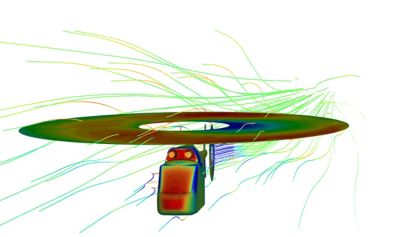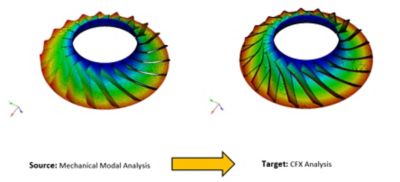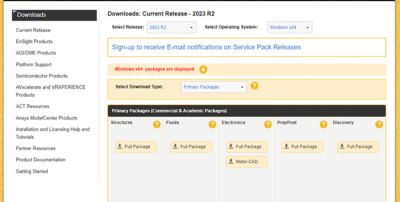-
United States -
United Kingdom -
India -
France -
Deutschland -
Italia -
日本 -
대한민국 -
中国 -
台灣
-
Ansys is committed to setting today's students up for success, by providing free simulation engineering software to students.
-
Ansys is committed to setting today's students up for success, by providing free simulation engineering software to students.
-
Ansys is committed to setting today's students up for success, by providing free simulation engineering software to students.
-
Contact Us -
Careers -
Students and Academic -
For United States and Canada
+1 844.462.6797
ANSYS BLOG
September 14, 2023
What’s New in the Ansys Fluids Product Line for 2023 R2?
At Ansys, our computational fluids dynamics (CFD) software tools include Ansys Fluent, Ansys CFX, Ansys Forte, Ansys Turbogrid, and more. These tools enable you to perform CFD analysis across a number of different industry applications — everything from de-icing on airplane wings and assessing the aerodynamics of a vehicle to analyzing the solder reflow on printed circuit boards (PCBs) and modeling the electrochemistry in batteries and fuel cells.
For the 2023 R2 software release, we’ve made substantial updates across the Fluids product collection, including advancements to Fluent’s multi-GPU solver, user interface (UI) and user experience (UX) improvements, and solver enhancements for decreased computational and memory overhead.
Fluent’s Multi-GPU Solver Updates
Fluent’s native multi-GPU solver was released in 2023 R1, enabling engineers to solve extremely complex and detailed simulation models natively on GPUs, with each GPU replacing the computing power of hundreds of CPUs. This has been a substantial focus area for Ansys as we aim to provide users with the ability to run simulations much faster without compromising accuracy on less hardware; and run long transient simulations that were previously impractical. Types of complex simulations that can be run on Fluent’s native GPU solver include automotive and aircraft external aerodynamics, equipment with rotating parts, and detailed mixing time analyses.
A six-million RANS-LES case with sliding mesh support on the Ansys Fluent multi-GPU solver. Running Fluent on two GPUs is equivalent to running Fluent on more than 1,000 CPU cores. This results in astounding performance gains, including lower power and memory consumption as well as exponential reductions in hardware costs.
In 2023 R2, the Fluent GPU solver updates include:
The ability for users to model rotating and stationary components utilizing the sliding mesh algorithm — useful for modeling rotating wheels in aerodynamics applications and full-wheel turbomachinery applications.
Availability of the eddy dissipation model (EDM) to match static temperature profiles. Reynolds-averaged Navier–Stokes (RANS) equation solution frequency controls are now available for stress blended eddy simulation (SBES).
Improved speed with asynchronous GPU solver execution that decouples it from the UI monitoring and residual plotting capabilities, allowing solver execution to proceed while the UI is concurrently updating.
Extended GPU solver build to run on the latest NVIDIA architectures, including NVIDIA H100 and RTX 6000 Ada.
Interested in the accuracy of Fluent’s native multi-GPU solver? Download our white paper.
Fluent Updates for Aerospace
Fluent provides extensive capabilities for aerospace applications, including external aerodynamics for subsonic, supersonic and hypersonic regimes, aeroacoustics, cabin/cockpit HVAC, in-flight icing, a dedicated Fluent Aero workspace, and more.
The virtual blade model (VBM) workflow was released in 2023 R2. This workflow is especially useful within the urban air market to predict how rotating blades will operate within specific flow fields. The workflow includes the ability to add bulk effects on the flow field without resolving geometric details of the blades, which saves users substantial solve time. In addition, there is a new floating disc capability which enables the creation of the VBM disc as a cell zone without needing to define a disc explicitly in the meshing stage. Mesh adaptation can be used if desired to refine elements around the floating disc.

Updates to Fluent’s virtual blade model (VBM) enable users to provide bulk effects on flow fields without needing to resolve the geometric details of the blades.
UX and Workflow Improvements
Several graphic enhancements and UI improvements have been made this software release, including realistic surface rendering utilizing the Intel OSPRray ray tracing engine. This brings a single-window workflow within a simplified UI, allowing live previews of camera settings in an embedded window, high dynamic range image (HDRI) light environment, and ability to manipulate for the environment imagery. This capability brings realism to simulation and added insights into simulation results.

Wave impact modeling on an oil rig using the new Intel OSPray ray tracing engine
Additional workflow improvements include lightweight set-up mode that enables users to quickly view and edit case setup with minimal computational and memory overhead. This mode can open a 6-billion cell case in 80 seconds, allowing you to quickly view and edit your setup without loading the mesh.
Developer Ecosystem — APIs and PyFluent
Recently, Ansys has been focused on creating a developer ecosystem where our users can run simulations through Python in order to expand, customize, and automate their simulations.
One way to do this is through application programming interfaces (APIs) that enable users to access Fluent’s solver settings and commands for advanced customization purposes. This enables users to build specialized solutions based on their own unique design challenges and requirements. For example, a user could invoke a Fluent command or series of Fluent commands alongside other third-party or open-source commands and operations all from the same scripting environment of one’s choice.
In 2023 R2, Fluent API expansions includes:
- Discrete phase models (DPM), radiation, species transport, VBM
- Mesh interfaces
- Poor mesh numerics, solution methods, and controls
- File-related commands
- TUI journal to Python journal converter
- Automates conversion of customer .jou file to .py file
- Wild card support for named objects
2023 R2 updates for PyFluent include:
- Field data improvement, including meshing mode implementation.
- Improved streaming services to support multiple data consumers and more multiple client connections.
- Batch-execute multiple operations in a single remote call.
PyFluent requires version 2022 R2 or later installed locally. Learn more about getting started with PyFluent.
Ansys Turbogrid and Ansys CFX 2023 R2 Software Updates
Substantial enhancements to Turbogrid in 2023 R2 include new meshing capabilities, including the ability to mesh Kaplan and Francis turbines with square trailing edges. The leading edge and square trailing edge detail using hybrid meshing enables users to capture the partial hub gap on the turbine. In addition, meshing with the ATM3D method now takes advantage of multi-threading, which provides an overall speed-up of 30%.
New workflow enhancements for CFX in 2023 R2 include a new system coupling capability for a more streamlined workflow between Ansys Mechanical and CFX for aeromechanics analysis. You can now easily transfer complex mode shapes from Mechanical Modal Analysis to CFD Aerodynamic Damping Analysis in CFX. System Coupling enables automatic geometry alignment between Mechanical and CFD models.

New in 2023 R2 is automatic geometry alignment between Ansys Mechanical and CFD models.
How do I Download the Latest Version of Ansys Fluids Software?
You can download the latest version of Ansys Fluids software at the Ansys Customer Portal (Ansys customer login required). Select “Current Release,” download the Fluids “Full Package,” and install the latest software updates to your computer.

Interested in learning more? Register for our “What’s New in Ansys Fluent 2023 R2” webinar.











